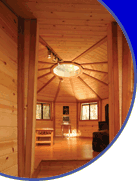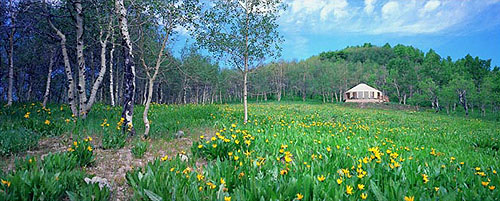
Most yurt questions are about the practical aspects of setting up a fabric yurt, dealing with climate issues, and designing systems for heating, plumbing and other utilities. You will find more detailed answers to these and other questions in Chapter 4 of YURTS: Living in the Round.
Where does the name “yurt” come from?
Scholar Peter Alford Andrews explains it this way:
The word yurt is misleading: most Westerners use it in the belief that it is a native term for the trellis tent when it is not…The Russian original, yurta, is a misapplication of the Turkic yurt meaning ‘territory’ or ‘camp site,’ but never ‘tent.’…The real Turkic names for the tent, ev, öy, or üy simply mean ‘dwelling,’ just as Mongolian ger does.
Andrews, Nomad Tent Types in the Middle East, p. 5
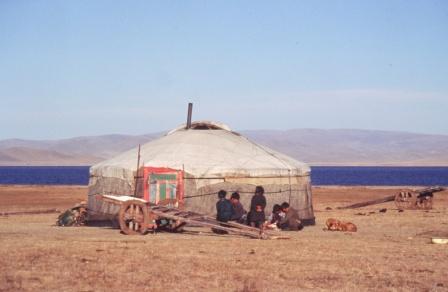
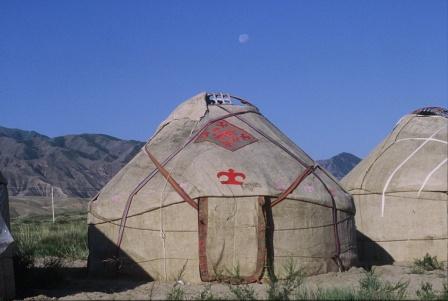
The term yurt has come into common usage in the Western world to refer to the traditional Central Asian nomadic round dwellings (the Turkic üy and Mongolian ger) as well as three modern North American variants (the portable fabric yurt, the tapered wall yurt and the frame panel yurt).
What defines a yurt?
In Europe, yurts are defined by their traditional Central Asian counterparts, meaning that in Europe yurts are portable trellis-walled homes with either a Turkic or Mongolian roof structure and door frame. Coverings are usually canvas, though some yurt builders are using felt as a middle layer.
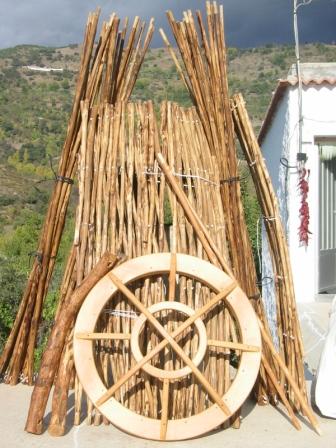
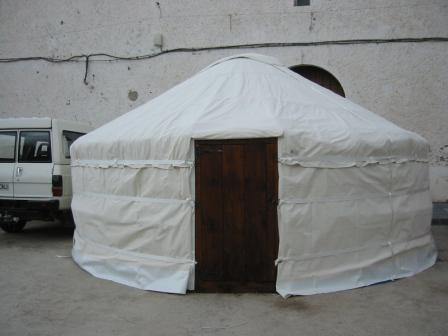
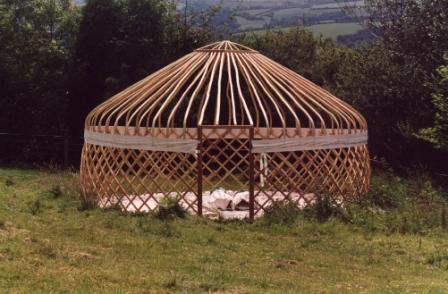
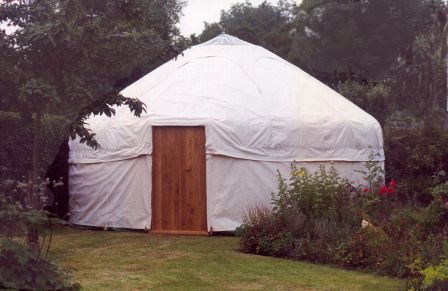
In North America, yurts are defined by their roof structure. The yurt roof incorporates a unique architectural design. Roof poles or rafters meet in a center ring, where gravity produces an inward and downward pressure. The center ring holds the rafters in a state of compression. Where the rafters meet the wall at the perimeter, a natural outward thrust occurs. A band (of rope, woven cloth or wire cable) at the top of the wall integrates the wall and roof structure and holds the roof poles or rafters in tension against this outward pressure.
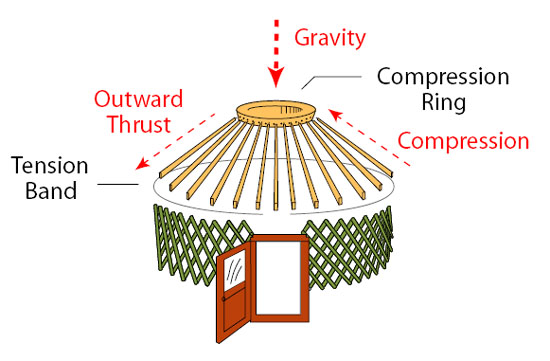
Diagram from “YURTS: Living in the Round”
showing the forces of tension and compression
in the yurt roof structure.
Because of this combination of the central compression ring at the top of the roof and the encircling tension band where the roof meets the wall, long roof spans are possible without any internal support system (like posts, trusses or beams). This gives the yurt an uncommon feeling of spaciousness and uplift. The roof design also creates an incredibly strong and resilient structure that is uniquely equipped to withstand earthquakes, strong winds and heavy snow loads.
What’s so special about yurts?
Yurts have many advantages, both tangible and intangible. An ancient nomadic shelter, yurts provide a reprieve from the rectilinear excesses of modern culture and remind us, through their circular form, of the unity and interconnectedness of all things. Versatile, beautiful and spiritual, both traditional and contemporary versions provide shelter that is affordable, accessible and gentle to the earth.
Modern fabric yurts cost about what one might spend on a new car in the US, or $5,000 to $20,000 (depending on yurt size and options added to the package).
Yurts are eminently accessible-once the platform is built, it takes one or two days for a crew of 4-5 to put up a fabric yurt.
Yurts are also flexible, with numerous possible uses from homes to studios and guest spaces. To have a shelter that can be put up quickly and then taken down and moved as one’s situation changes is also a distinct advantage in our transient culture.
The portability and affordability of the fabric yurts make them an attractive option for people who want to experiment with community living before making a long term commitment and large financial investment. The flexible nature of the yurt works well for intentional communities, where it can be used to meet a variety of needs over time (e.g., meeting space, housing and yoga studio).
Being round, yurts make better use of space than their rectilinear counterparts, are more efficient to heat, and provide less wind resistance. The roof structure, with its compression ring and tension band, is an amazing architectural design providing a great deal of strength and requiring no internal support system, thereby leaving the yurt open and spacious inside.
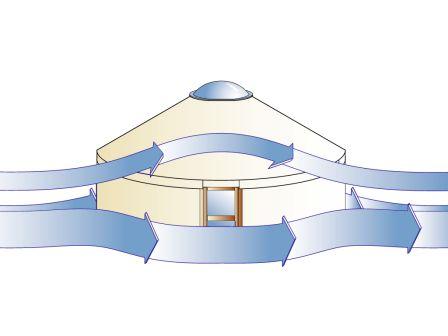
The wind naturally moves around a yurt.
Courtesy of Pacific Yurts.
The rounded yurt fits into its natural surroundings more easily than rectilinear buildings, and the Central Asian and fabric yurts leave a very small footprint. Fabric yurts provide a healthy option for people with chemical sensitivities because of the less-toxic materials used and more frequent air exchange. They are also aesthetically attractive-a warm, embracing, nourishing structure.
The healing, creative, communal and spiritual nature of yurts is broadly recognized. Yurts seem especially suited to certain pursuits. They are often used in retreat centers and for the healing arts, meditation, spiritual practices, dancing and community gatherings. People seem to sleep better in yurts, and often dream more.
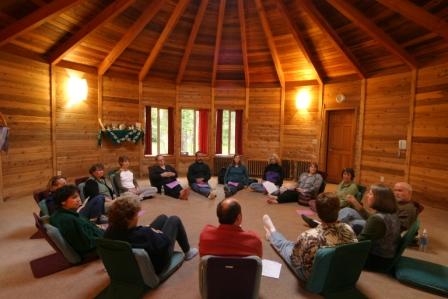
This frame panel yurt at Breitenbush Hot
Springs Retreat Center in Oregon initially
housed a Watsu pool and today functions
as a workshop space.
Annie Raitt, cofounder of California Yurts, describes the intangible, “feeling” element of yurts:
People are very much affected by these structures, whether they are modern Americans or an indigenous person on the steppes of Central Asia. There’s the primordial and spiritual and community appeal of living in a round structure, with its connection to our ancient roots. There’s also the quality of the space itself.
With its embracing walls and its open-at-the-top architecture, the yurt is both a protective and soothing space and a symbol of the metaphysical quality of being open and receptive to what life has to bring you. It seems to have a very positive impact on people who come into contact with it.
What are yurts used for?
Yurts have many applications, including State Park camping, back-country skiing, schools, offices, shops, studios of all kinds, bed-and-breakfasts, a camp kitchen, a women’s moon-lodge, and resort accommodations to name just a few!
For some great examples, see:

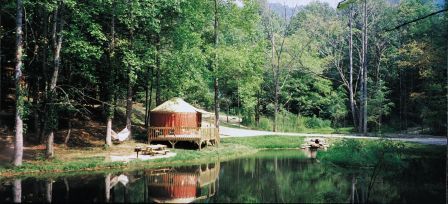
How much does a yurt cost?
Modern fabric yurts cost about what you’d expect to pay for a new car, around $5,000-$20,000 depending on the size of the yurt and the options included. Colorado Yurt Company expresses it well on their website:
The cost of the yurt itself generally ranges from around $5,300 – $18,000 depending on size and upgrades. Other costs you may incur are shipping, land, platform, interior furnishings and electric, solar or plumbing installations.
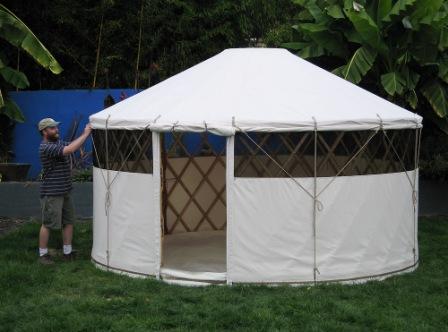
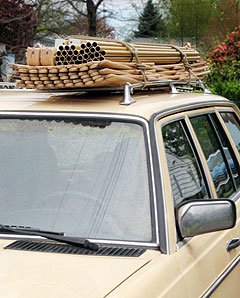
Lightweight and easy to setup, GoYurt Shelters are truly portable.
Camping yurts range in price from $2500-$4,000, and can include a ground cloth. They function best as backyard yurts-as guest quarters or a meditation space-and for long-term camping. (For examples of camping yurts see GoYurt Shelters and Rainier Yurts)
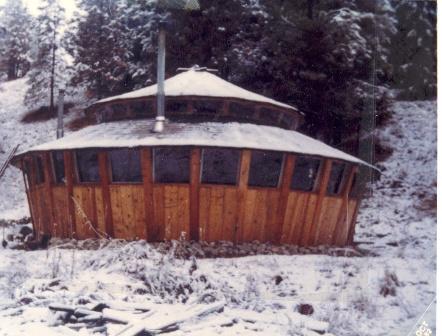
The tapered wall yurt can be built
from plans offered by the Yurt
Foundation in Maine.
You can build one of Bill Coperthwaite’s tapered wall yurts yourself, in which case you’ll have to pay for a set of plans and the materials (which range from $3,000 to $30,000 depending on size and style of yurt). You can also have Bill come out and lead a workshop (for $400/day) to help you and a group of a dozen participants put up a yurt in 5-10 days.
If you’re considering a frame panel yurt, the cost is dependent on how much work you’re willing to do yourself and how much you want to pay someone to do for you.
Oregon Yurtworks says,
Generally, we have found that for the owner/builder our round houses will average $100-130 a square foot for a finished home. With someone else acting as general contractor the price will range from $130-150 a square foot, depending on the size, style and types of materials selected for the finishing touches. Shipping and transportation costs are additional.
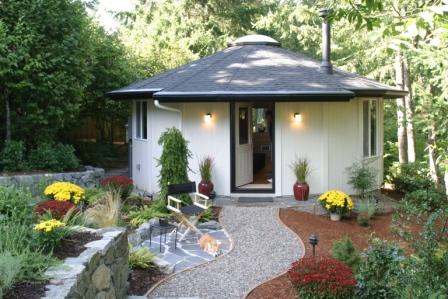
Frame panel yurts are often custom
driven and can vary a great deal in cost.
Because Mandala Custom Homes’ frame panel yurts are custom driven, costs vary greatly, from $55 to $100 per square foot (not including shipping).
The cost of a Smiling Woods frame panel yurt kit can be as little as $30 per square foot for the kit itself (this applies mainly to the exterior shell and you will need to do the set up and finish work). Doing the work yourself, you could finish this yurt for a total of $55-$70 per square foot. Hiring a contractor will cost $75-$90 a square foot, depending on your taste. Shipping is additional.
What kind of foundation does a yurt require?
In Central Asia gers are set up on the grassy plains, and rugs and felted mats are placed on top of the grass. In the winter pallets or shallow wood decking may be used to create a floor, and felted mats or rugs are layered on the flooring for insulation and warmth. Central Asia is very dry, and what little precipitation does occur is usually in the form of snow so there is little danger of water leaking or flooding inside the ger.
In North America and Europe, with areas of greater precipitation, yurts are typically erected on a platform. The circular platform is built to the size of the yurt, as the yurt’s outer covering will be attached to the platform itself or under the platform.
Most yurt companies will send plans for a deck in advance of your purchase, so that you can build the platform before the yurt arrives. A sample platform design is included in the Appendix section of YURTS: Living in the Round; however it is important to follow the design that your yurt company uses as each company has their own way of integrating the yurt with the platform. Some companies include a design for a portable deck, and others will sell you a pre-fabricated portable deck.
Here’s some further information on decks:
Platforms and decking from Colorado Yurt Company
Pacific Yurts’ platforms and decking
Portable platform options from Yurtco
In a semi-arid or dessert climate, it’s possible to set up a fabric yurt directly on the ground. It helps to have a rock-filled trench around the perimeter of the yurt for drainage. For extra insulation you can dig the circle down six inches, lay in plastic sheeting, fill it in with sawdust or sand, and place your floor coverings and rugs over the soft sawdust floor. A yurt community in Kelley, Wyoming (near Jackson Hole) has lived this way successfully for many years. (For more detailed instructions, see YURTS: Living in the Round, p. 78)
My favorite yurt of all time had an earthen radiant floor-in this case with hot springs water piped through it. (The floor was made from cob, an adobe-like mud mixture made from clay, sand and straw.) The floor had a natural, earthy feel and the radiant heat kept the yurt cozy on the coldest of days.
Can yurts be joined together?
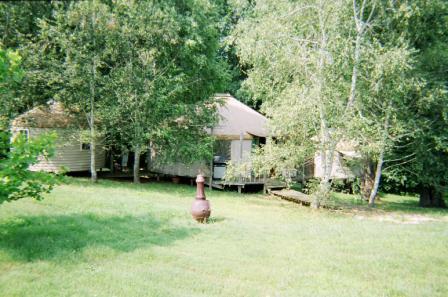
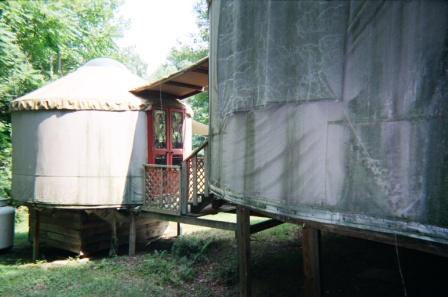
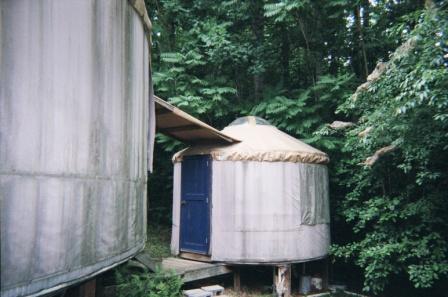
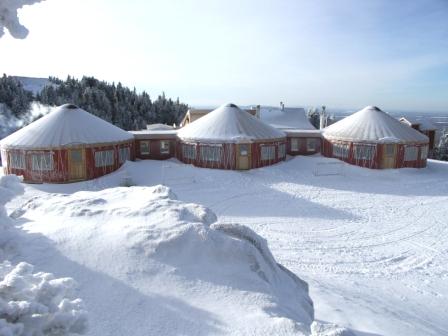
Mt. Orford Ski Resort in Quebec,
Canada uses covered walkways to join
their three yurts.
There are a few methods for joining yurts. The photos above show a 30′ yurt with 16′ “pods” radiating out from it, joined using attached awnings.
This French yurt website shows how yurts can be joined at the doorframes.
Here are some photos of adjoining Nomad Shelter yurts.
Pacific Yurts also shows examples of connecting yurts.
Do yurts work in cold climates?
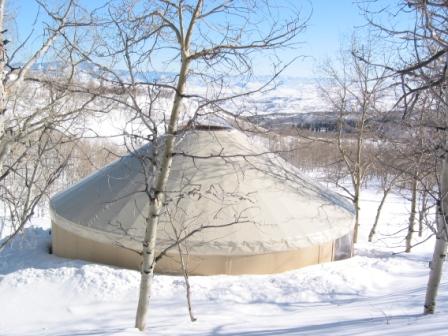
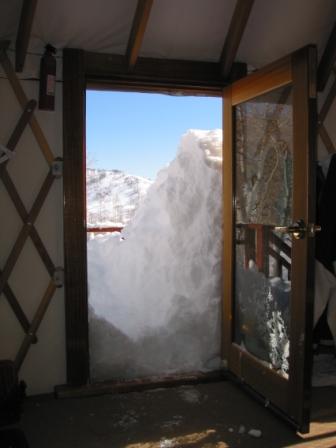
Yurts were designed for use in some of the coldest climates on the planet. Their circular nature makes them more efficient to heat (with 12% less surface exposed to the elements than their rectilinear equivalents).
The felted covering of Central Asian gers is well suited for the cold, dry conditions of the Asian steppes, where the nomads add extra layers of felt when the temperature drops.
Felt doesn’t work well in the damper climates of Europe and North America, where some form of canvas or architectural fabric is used as a covering instead. Because canvas and most architectural fabrics don’t have the natural insulating qualities of felted wool, some type of insulation is usually added.
Most yurt companies use a NASA-developed reflective insulation which consists of a layer of bubble wrap sandwiched between two reflective foil layers. The foil works by reflecting radiant heat in both directions (to keep the heat inside in the winter and outside in the summer), and is a lightweight but highly effective form of insulation. Adding multiple layers of reflective insulation is not recommended, because the added benefit is minimal relative to the additional cost.
A number of other options are available, including the fiber-fill used for quilting, synthetic felt (placed inside the canvas layer with a vapor barrier between), and a recycled cotton (blue jeans) insulation with reflective layers on one or both sides.
Alaskan company Nomad Shelter has some additional insulation suggestions for extremely cold climates.
Insulating the floor is important. One can place standard types of insulation under the floor (e.g., blown-in or rigid foam) or use stress skin insulated (SIP) panels to build the deck itself. A number of yurt companies can supply you with a fully insulated portable SIP panel platform.
How do you heat a yurt?
You can use pretty much any kind of heat that you’d use in a conventional home; however, most yurt dwellers use wood heat or propane. Another great option (though fairly permanent) is a radiant floor (where warm water circulates through pipes in the floor)
Here are some aspects to consider with the different heating options:
- Wood or pellet stoves The advantages of wood and pellet stoves are that they are renewable resources and that they produce a dry heat, keeping the yurt much cozy in wet climates. It is possible to find efficient stoves that produce minimal emissions. A ceiling fan is helpful in circulating the warmth.Here are some photos of stovepipe installation from Colorado Yurt Company.
- Propane heaters A propane heater produces water vapor and carbon monoxide as byproducts of combustion, so they need to be vented and should be installed by someone who knows what they are doing. Unvented propane heaters make a yurt damp (causing mold problems) and can cause carbon monoxide poisoning (symptoms include headache and nausea). A portable fan clipped to the rafters above a propane heater, or a ceiling fan, can help send the heat across the room or back down from the ceiling.
- Radiant heat also called hydronics (hot water in the floor). This is the most efficient and comfortable form of heating for any shelter. The floor is usually poured concrete with tubing running through it, but it can also be made of cob or adobe. Options for heating the water include a wood or propane-fired boiler, a wood stove, and electricity.
Pete Dolan of Pacific Yurts gives this example of a yurt with a framed-in radiant floor:“We had a customer who built a rectangular structure with structural insulated panels (S.I.P.) for the roof that were around R-30. On top of this structure he laid the 2×6 joists for his circular yurt platform and had the water tubes snake between the joists. He then laid plywood flooring over the joists. A propane-fired hot water heater in the rectangular structure supplied the hot water for the radiant heat.” - Rocket Mass Heaters use thermal mass to store and then release heat for 6-12 hours. These heaters are efficient in their use of fuel (wood), non-polluting, and you can build it yourself! Check out Rocket Mass Heaters by Ianto Evans. (link to yurtinfo.org “bookstore” where they will find a description of the book and can purchase it)
- Electric heat in the form of baseboard heating or radiators is probably the least desirable option because of its inefficiency and high energy usage.
To find more information on heating, go to Pacific Yurts or Rainier Yurts heating Q&A.
What about yurts in tropical climates?
Yurts are ideal in those tropical climates where heating needs are minimal and cooling needs can be met with proper siting and adequate ventilation. Areas where both temperature and humidity range are high and most homes require air conditioning, are probably not good candidates for fabric yurts.
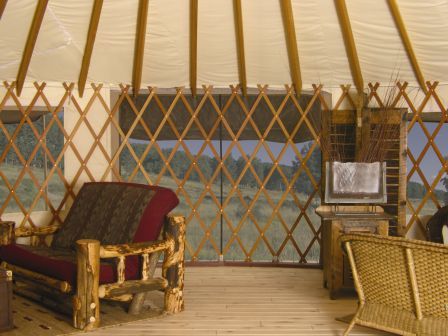
A full wall panel screen offered by
Colorado Yurt Company as an option.
Yurts are probably more difficult to keep cool than they are to keep warm. It seems obvious, but siting a yurt under deciduous trees is your best option for keeping it cool. Turning your window covers into awnings (and perhaps covering those awnings with reflective foil) will help a great deal. Installing reflective insulation is vitally important in reflecting the sun’s heat away from the yurt. And ventilation, of course, is key-with some of the yurt designs it is possible to roll up the sides and hang mosquito netting across the lattice wall (another version of this would be the full panel wall screens that are options with some companies).
Pacific Yurts has this to say about tropical applications:
For tropical use add top cover insulation, tinted dome skylight with opener for ventilation, extra screened windows, porch and window awnings and ceiling fan support. A water catchment option is also available (water catchment is a primary source of water supply in many tropical countries).
Pacific Yurts also has a tropical cupola, a center ring insert and screen doors available for tropical applications.
See also: Rainier Yurts
Can yurts handle hurricanes?
There’s a two-part answer to the hurricane question:
- One can never know for sure what will happen in an extreme situation like a hurricane. We do know that yurts do well in high winds, partly because they are circular (and therefore the wind goes around the yurt, with no corners to catch the wind). The other factor is the amazing strength and flexibility of the integrated roof and wall structure (the whole structure being held in tension between the central compression ring and the encircling tension band).I heard a story about a fabric yurt in Japan surviving a tornado in Japan that damaged nearby houses. The only thing that happened to the yurt was that the skylight bubble blew off, which I’m told is a design feature to allow for pressure release when a vacuum is created inside, thereby keeping the yurt from imploding.
- If you live in an area prone to hurricanes, you may want to go with a wooden yurt instead of fabric. Although it’s unusual, I’ve heard a couple of stories about fabric yurts being damaged in high wind situations; it may be better to be on the safe side and purchase the permanent option.
Whether you choose a fabric yurt or one of the permanent wooden yurts, a round home of some sort is definitely your best bet in a high wind situation.
Are yurts bear proof?
Yurts are usually bear proof-they may tear through the fabric (which can be replaced) but they can’t get through the trellis wall which is very strong. For a list of bear proofing tips, go to page 73 in YURTS: Living in the Round.
Are yurts secure?
People in cities often ask about yurts and security. In some cities no one is safe, however in most rural situations there isn’t much vandalism to begin with. Yurts are hard to break into because of the trellis wall. Even if a thief cuts the fabric, they will still be blocked by the trellis wall, which by the way covers even the windows. Your only weak spot would be windows in your door that could be broken (just like they could in a conventional house). Canadian company Yurtco even has this handled with unbreakable glass in their door windows.
Yurtco has this to say about security:
Yurtco uses standard size, insulated exterior doors, and all door windows contain unbreakable glass with an inner laminate core. The continuous heavy-duty wood lattice wall spans from one side of the door frame to the other, even through the windows, which means the only way to break in would be through the doorway, and with unbreakable glass, this is not possible.
What about permitting?
Building codes and permitting is a complex issue that varies with location and with the style of yurt you’re considering. The frame panel yurts don’t normally have code issues, being basically stick frame construction which has few code restrictions.
If you’re considering a fabric yurt, you’ll want to check with your local code officials before purchasing a yurt. For a list of questions to ask your Building Code Department, see chapter 4 in YURTS: Living in the Round. Some of this information is also excerpted for you in the Yurts and Codes section on this site. Hint: when you go to meet your local code official, take either the book or a yurt company brochure with you so that you can show the official what type of structure you’re talking about.
You might also find it helpful to use a consultant to help you work on this issue. See also Pacific Yurts’ codes section.
What about building a yurt myself?
If you have skills in carpentry and/or sewing and want the experience of building your own shelter, then by all means order a set of yurt plans or read the books on making traditional yurts (The Complete Yurt Handbook, Mongolian Cloud Houses and Circle Houses), and go for it.
You’ll find stories of people who’ve built their own yurts in our Yurtspeak newsletter and answers to some common questions on the Forum.
To make a fabric yurt you’ll need a commercial sewing machine (which can be rented), woodworking tools and a workshop space. Keep in mind that some of the available plans available are for rustic camping-type yurts, while other plans will be more suited to year-round living.
If crafting is not your forte, you might prefer to purchase a yurt from one of the companies listed on this site. Keep in mind that the markup with most fabric yurt companies isn’t very high. In most cases you’re getting a pretty good deal.
If wood is plentiful where you live and you’d like something more permanent, take a look at Bill Coperthwaite’s plans for his tapered-wall wooden yurts. One has to work with the walls a little differently when they’re slanted outward, but the spaces are unique and have a wonderful feel. A yurt workshop with Bill Coperthwaite is both educational and a community building exercise.
If you think you’d like to try a frame panel yurt, contact Smiling Woods Yurts. They will sell you plans for the frame panel walls, which you can build yourself, and will also sell you a metal roof kit (which is the complicated part), ready to put together. This allows you to build for yourself and save money, while also reducing the frustration level where the learning curve is highest.
Which companies do you recommend?
It is important for the future of yurts that people receive good customer support from yurt companies, that yurts are honestly represented, and that companies meet their obligations with integrity. All of the companies listed on the Yurt Companies section on this site, as far as we know, have good customer relations and can be trusted to deliver what they promise.
For more information on companies, see our How to Buy a Fabric Yurt section.
If you would like to read about people’s experiences with different companies, or share your own experience, you can visit the Yurt Forum. The most typical issues expressed by frustrated yurt buyers are incomplete kits (parts missing), poor instructions and lack of adequate customer support.
Is it possible to have utilities (like electricity and plumbing) in a fabric yurt? What about solar power?
Most of the utilities used in conventional homes can be installed in a fabric yurt. Plumbing and electricity are usually brought up through the floor and may be run through interior walls that you install in the yurt to create rooms.
In a cold climate it may be helpful to build a small permanent outbuilding that you can super-insulate and in which you can bring up plumbing for kitchen and bath facilities. You can install a propane heater and thermostat in the outbuilding to keep your plumbing from freezing while you’re gone, without having to heat the entire yurt.
Another option for cold climates is to install plumbing that is easily drained when you leave for any length of time during the winter months.
Many fabric yurts are used in remote locations where it is common to use solar power, water catchment systems, and composting or sawdust toilets (see The Humanure Handbook).
For more on utilities, see Rainier Yurts and Pacific Yurts.
How long does it take to put up a yurt?
It may take three days to two weeks for the deck, depending on site and weather conditions, the size of the yurt, and the experience level of the builder(s). We recommend working with a professional carpenter for the deck. See Lars’ Yurt Page for photos of a portable deck being built.
The yurt itself usually takes under a day to set up with four or more people. A 30′ yurt may take two days.
I’m nervous about putting up a yurt myself. Is there a place I can see one going up, or learn more before I put one up myself?
Check out the yurt raisings on our yurtinfo.org calendar (and when you get ready to put up your own yurt, please email [email protected] let us know so that we can put it on the calendar). Some of the yurt companies occasionally run yurt raising workshops for their potential customers. If you’re within driving distance of a company, have them put you on a list for a workshop-it’s your chance to learn from the experts!
Many of the companies have an expert that they can send out to help you and your crew put up your yurt-or you can hire someone from our consultants list. Your cost is their daily rate plus travel, and you’ll have an expert by your side!
But really, most of the companies have excellent instructions with their yurts and-especially if you designate one person to do nothing but read the instructions, and you don’t do a single step without reading the instructions first-yurt raisings usually happen pretty smoothly.
To view yurt raisings, see the
Pacific Yurts assembly video, Colorado Yurt Company’s yurt raising slideshow (including a portable SIP platform) and Yurtco’s Building a Yurt slideshow.
How long should a yurt last? What kind of maintenance is required?
The wooden framework of a yurt is built to last indefinitely. The architectural fabric coverings are usually guaranteed for ten to fifteen years, and often last longer. High UV situations (lots of direct sun) break down the fabric faster, and rainforest sites may cause disintegration from molds or mildew. Other issues have to do with some shrinkage on the clear vinyl windows and Velcro (around the windows) wearing out.
In a wet climate it’s good to scrub the walls down every six months with a fungicide (Shaklee’s biodegradable Basic G germicide works well). In a climate with a lot of sun exposure, some yurt owners have painted the outside of their fabric walls with latex paint to make it last longer (this will affect the breatheability of the fabric). Canvas treatments used for sails and canvas tipis might also be helpful.
What about storage, privacy, and interior design options?
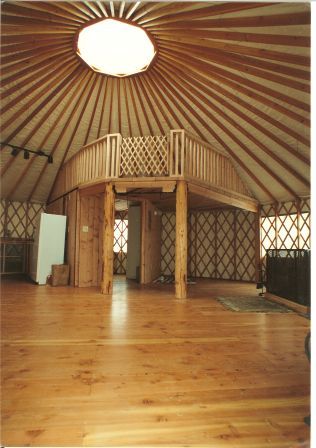
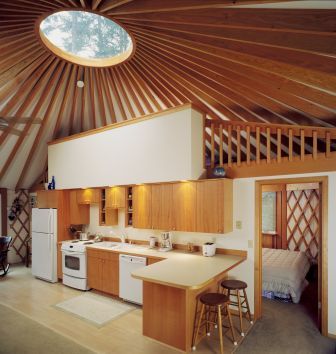
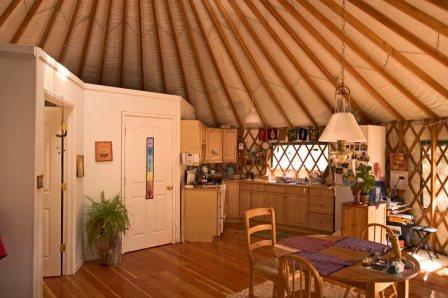
Here are some ideas:
- Some people prefer to keep the central space open and create “rooms” around the perimeter, like the Central Asian nomads do; others choose to build a loft or even rooms.
- You can use light weight, moveable furniture for flexibility and pale or muted colors to keep the feeling of openness.
- Consider Japanese and Swedish design ideas like under-the-floor storage, or roll-away drawers under beds and sofas. The IKEA (Swedish furnishings) catalogue is a great place to start.
- For privacy, you can hang fabric from the rafters (fishing line works well) or use moveable screens.
- Rather than building a large yurt and then using walls to break it up into small rooms, consider using multiple smaller yurts to create different functional spaces and provide privacy. One might, for example, combine a living/bedroom yurt and a studio/office yurt, or install separate smaller yurt bedrooms around a shared kitchen and living yurt.
For more information on yurt interiors, go to Chapter 6 of YURTS: Living in the Round, or view the interiors sections at
Yurtco,
Pacific Yurts and Rainier Yurts.

For more detailed answers to most of these questions, see the book “YURTS: Living in the Round”, available through this site, on Amazon, or at your local library. For questions that aren’t answered in the book, join us on the Yurt Forum.
The following yurt company websites have helpful FAQ sections:
